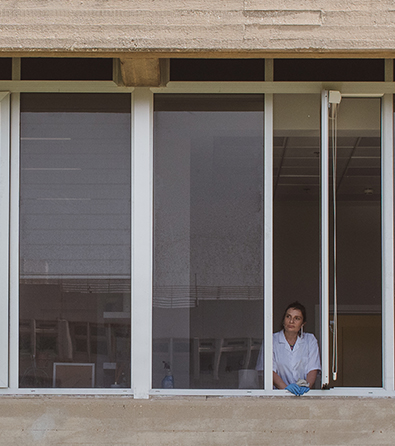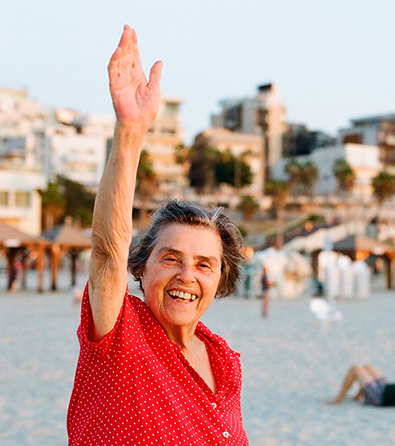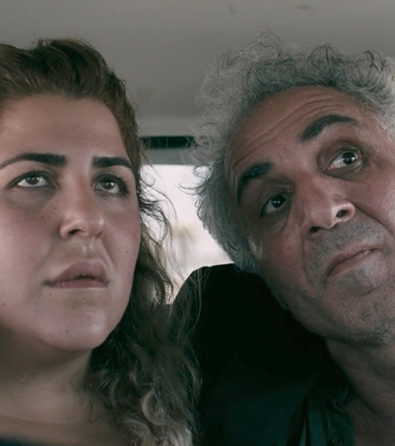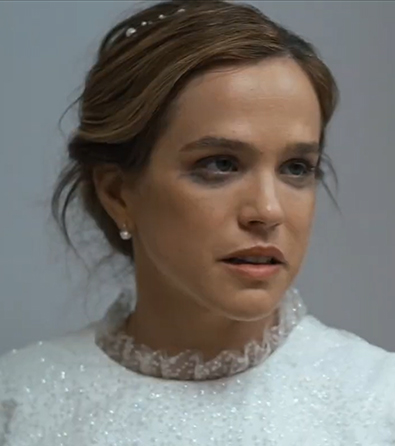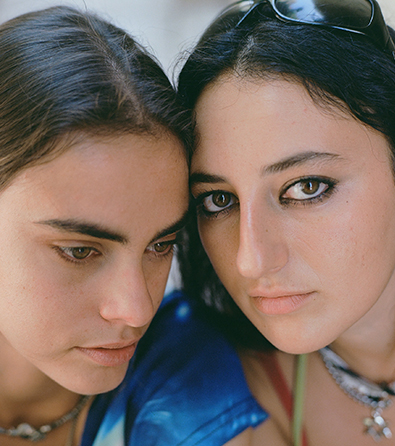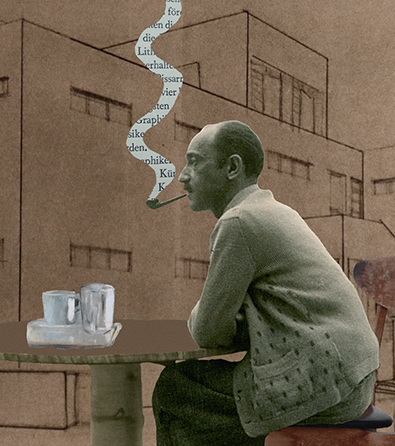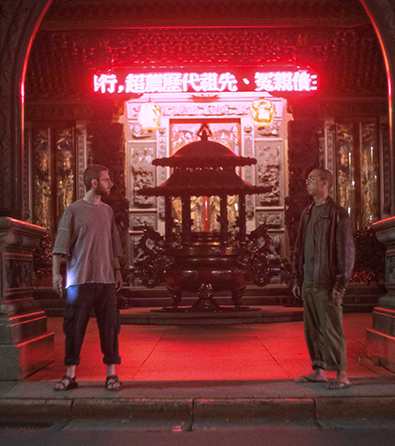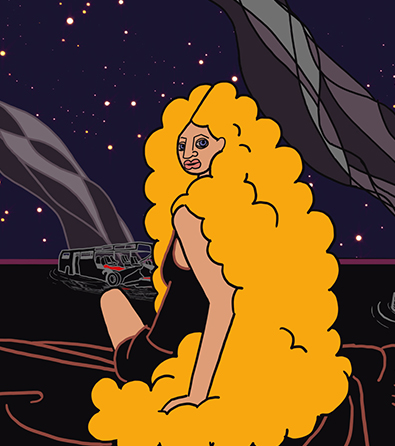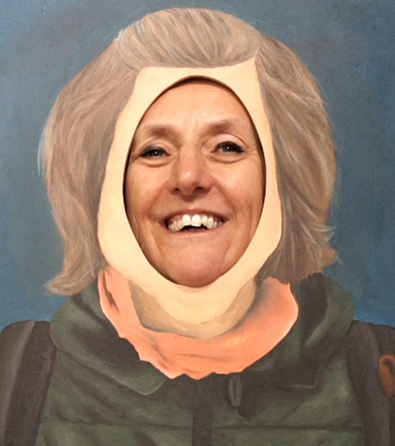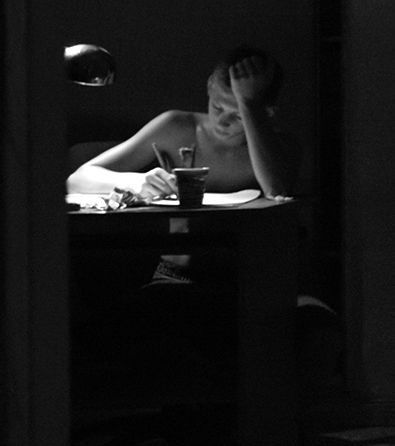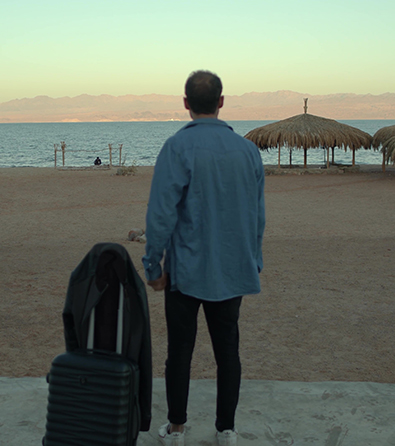The short film Salma (15 minutes) is available to watch at the top of the page.
* To watch this film, please approve YouTube/Vimeo cookies via the blue cookie icon at the bottom left of the screen.
Salma, directed by Sohela Ghattas, follows a young Palestinian woman in Israel determined to break free from the restraints of her family and the men who threaten her life.
With a distinct visual style – framed entirely from Salma’s perspective, where the camera functions as her eyes fixed in direct gaze at the men around her – the film forges a cinematic language that documents and exposes violence against women.
Salma is a university student, unmarried, and in a relationship with her partner, Youssef. Her brother and father are abusive, resentful of the freedom she claimed for herself by leaving home to study and work. Her mother, too, suffers under the violence of her husband. Walid, Salma’s brother, once beat her simply for wearing a sleeveless shirt.
The film unfolds through the complaint Salma files at the police station. Her answers to the investigator’s questions gradually uncover the circumstances of her life. The officer assigned to her case not only asks invasive and humiliating questions – such as whether she is a virgin – but also validates the violence inflicted on her by the men around her and blames her for its consequences. This exchange between Salma and the officer adds yet another layer to the film’s portrait of the Arab community in Israel. The officer himself is ambiguously portrayed – perhaps a Mizrahi Jewish cop, maybe an Arab officer – speaking to Salma in Hebrew while she replies in Arabic. His figure embodies a man aligned with the Israeli establishment, representing patriarchal authority, the police’s incapacity to address crime against women, particularly within the Arab communities in Israel.
The film critiques violence against women and so-called “honor killings,” while simultaneously raising broader social and class questions. Salma’s partner, for example, is depicted as a bourgeois intellectual who attempts to protect her, but the only way he can do so is by marrying her and obtaining her parents’ approval. Even he becomes a target of Walid’s threats of violence.
One of the most striking aspects of Ghattas’ film is the use of the camera as an unflinching mirror. Salma gazes at the men in her life – her violent brother and father, the racist and chauvinistic police officer, and her educated partner who fails to protect her. The choice of a frontal cinematic mode creates a sense of entrapment around Salma as a protagonist, yet at the same time, the camera grants her control over the power dynamics in each scene. The viewers are not merely witnesses – they share Salma’s gaze and are compelled to look at the men and women surrounding her exactly as she looks at them. The camera tells a story of oppression, but more than that, it embodies this oppression through visual, material, and physical means.
Through its cinematography, Salma is not the object of the story but the subject who shapes it. The camera is enlisted in the service of the rebellious female presence, allowing the audience to connect with her inner emotions rather than only the external narrative. In its short length and compressed style, Salma evokes a suffocating atmosphere generated simultaneously by its visual language and its narrative. Thus, a unity is created between the act of filmmaking and the story of oppression. The film depicts violence in a way that makes the viewer almost feel it physically, forging a connection between the aesthetic and the political, between personal style and a broader social vision.
Emerging from both aesthetic and social interpretations, Ghattas proposes a subversive cinematic practice grounded in a distinctly female gaze – one that seeks to destabilize the power relations between subject and object, man and woman, victim and storyteller, all of which converge in Salma’s character. The decision to position the camera at Salma’s eye level and align it with her perspective throughout the film makes the viewer an active participant in the experience of oppression – not merely a witness, but directly involved. This is not a cinema that represents reality – it makes reality present in tangible form.
Salma’s everyday reality is a terrain of oxymorons: the home, meant to symbolize protection and security, becomes a space of physical, verbal, and symbolic violence; the street is a hostile environment; even the university and the intellectual sphere are not immune to humiliation. Boundaries blur, and Salma navigates between them with increasing self-awareness.
One of the film’s strongest elements is the way the male characters – the father, the brother, the police officer, and the partner – are portrayed not as a single monolithic entity but as distinct mechanisms of control over her. Salma’s partner, for instance, seems modern and educated, yet he remains trapped within the dictates of society. He is ultimately forced to choose between his intellectual convictions and submission to traditional power structures. The most complex figure in this regard is the police officer, whose formal Hebrew sets him apart from Salma, who responds in Arabic. This linguistic divide also underscores a cultural difference.
As Anna Ball notes in her book “Palestinian Literature and Film in Postcolonial Feminist Perspective” (2012), contemporary Palestinian cinema succeeds in sustaining a tension between critiquing patriarchal structures while maintaining loyalty to national identity, underscoring the friction between external politics of occupation and internal gendered oppression within society. In this context, Ghattas succeeds in creating precisely this tension: oppression in the film is not only “Israeli,” but first and foremost domestic, familial, intimate. Yet it unfolds within a broader social framework, one in which norms sanctify family honor above the dignity of the daughter.
One of the film’s most striking moments is the dinner scene, seen through Salma’s eyes. It begins with a close-up of a chicken being torn in two by the men’s hands. The image is charged and allegorical: the meat splintering into fragments in the family’s hands while the camera observes the act of dismemberment. More than food, the chicken becomes a direct representation of Salma’s body – an enactment of control, cutting, consumption, possession. This visual metaphor reinforces what runs throughout the film: violence against women is not only physical, but also cultural and linguistic, inscribed into every detail of daily life.
The spaces in which the film unfolds – the home, the street, the police station, and the cafeteria – are all constructed as both gendered and political. In this context, Colleen Jankovic and Nadia Awad observe in their article “Queer/Palestinian Cinema: A Critical Conversation on Palestinian Queer and Women’s Filmmaking,” published in Camera Obscura (2012), that one of the tendencies in Palestinian feminist cinema is the creation of alternative aesthetic spaces where the female body signifies resistance without resorting to overt political didacticism. Salma does not deliver speeches or raise her voice at rallies. Her resistance resides in silence – in the steady gaze she directs at those who oppress her, in her body language as conveyed through the camera’s movement, and in her decision to confront broken systems again and again.
The father and brother embody the patriarchal mechanisms that threaten the movement, fulfillment, and freedom of women.. When a woman attempts to cross the boundaries of the home, their lack of support only intensifies the physical and symbolic threats she faces – body against body, boundary against boundary.
The brother, Walid, functions as a representative figure of a young man projecting his frustration onto his sister’s independence. The brutal violence he inflicts on her – even for something as minor as wearing a short-sleeved shirt – illustrates how the urge to control a woman’s body finds seemingly legitimate expression within family conventions. The father, as head of the household, minimizes these assaults while upholding family honor as a supreme value, at the cost of his daughter’s safety.
Data from Israel in 2024–2025 present a horrifying picture: according to reports on violence against women and femicide in 2024, relatives murdered dozens of women over the age of 18, and dozens more by others. Cases of femicide under the pretext of “family honor” within the Arab communities in Israel are sharply increasing. Yet, this issue remains absent from visual culture and is rarely addressed in either Israeli or Palestinian cinema. Both largely avoid confronting femicide in general, particularly when partners or relatives perpetrate it. “Salma” addresses violence against women with courage within the short film format, raising ethical, aesthetic, and gendered questions about silencing in its broadest sense – why is this subject silenced in local cinema? What space does cinema have to confront familial fear and violence?
The absence of engagement with this subject in Israeli and Palestinian cinema is striking, and yet several international and local documentaries have been produced. The Indian filmmaker and journalist Lipika Pelham, who often addresses the stories of women in traditional societies under oppression, directed the documentary “Deadly Honor” in 2009. The film recounts the story of a girl named Salma from Ramla who survived an attempted murder by one of her relatives. It documents the terror shaped by a social code of silence in which no one dares turn to the extended family, friends, the police, or the authorities.
In 2011, actress and director Abeer Zeibak Haddad created the documentary “Duma,” in which five Palestinian women recount experiences of sexual assault within the family and speak of the silence imposed by fear of even harsher repercussions. As can be seen, important works do exist, but most reach only a limited audience within the documentary framework. This raises the question of whether the reason lies in fear of overstepping political and social correctness, or whether cinema as a whole chooses to distance itself from the stories of women under oppression. Another issue is the extent to which cinema contributes to the cultural silencing of subjects it avoids – such as femicide. Moreover, cinema’s turning a blind eye reflects a broader social neglect of crime and violence against women. A bold cinematic confrontation is required, one that will expose the phenomenon and present it not as “someone else’s problem” but as an issue that concerns us all, ideally through a cinematic language that combines the aesthetic, the feminist, and the social – as in the courageous hands of Ghattas.
Under the camera’s gaze, even the simplest acts like attending university, renting an apartment, or wearing a short-sleeved shirt become revolutionary gestures. The decision to construct the narrative around the filing of a police complaint – a formal, legal, and public framework – culminates in the film’s climax, where the dialogue between Salma and the officer reveals the very essence of oppressive mechanisms. Not only does the officer fail to protect her, but he also enforces a patriarchal discourse upon her.
Yet even in her moments of powerlessness, Ghattas frames Salma in a way that prevents her from appearing as a helpless victim. The intimate cinematography conveys a sense of confinement, but also of resilience. It is a cinematic portrayal of female steadfastness – of “sumud,” a Palestinian term meaning “holding on to the land,” which in this context signifies non-violent resistance to oppression. Salma does not emerge victorious, but neither does she surrender. She remains documented, present, and determined.
Salma not only bears witness to the problem but also issues a call to action. It makes clear that change will not come through legal systems, nor does it depend on a male savior from outside. It begins, perhaps, with the very ability of women to tell their own stories and to return a steady gaze.
